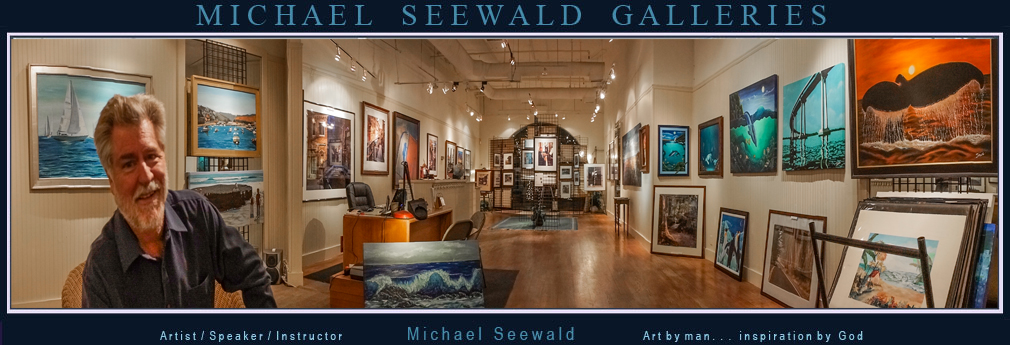'Photographers Forum' Magazine.
Nov. '93 issue.
Michael Seewald-
Finding His Niche in
the Fine Arts World
By Manuel J. Rodriguez
Special to Photographer's Forum
Note: Updated facts (thru 2.2019) and comments by Seewald are
indicated by the [info in brackets].
It was raining with the sky a slate gray. In the Italian port city of Genoa, Michael Seewald had boarded a bus heading out of town. Looking out the window he spied it: three pastel walled buildings perched on a cliff hovering over the Mediterranean Sea. He realized the photographic possibility. Quickly, he exited the bus.
Setting up his Mamiya RB67, Seewald determined his basic composition. Then he started making adjustments. Move a bit to the left. Move a bit to the right. Come closer. Pull back. Yet after about 30 minutes of fine-tuning, Seewald realized the image still was missing something. The far left appeared empty. A compositional element was needed to balance out the buildings at right.
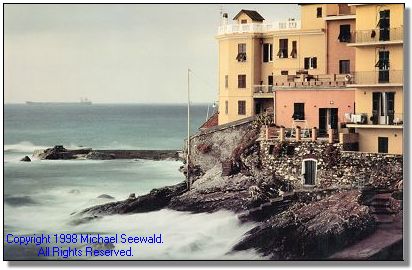
Genoa, Italy, '89
Sponsored by Marc Slott, Encinitas, Ca.
Click photo to enlarge.
Seewald, a spiritual man who believes in the power of prayer, petitioned God to assist him out of this quandary. 'I asked God to supply me with something ... a bird flying into the frame, or a sailboat cruising by,' Seewald recalls. Shortly after, along the
"I heard someone say once that you can see a million images per day,' he explains. 'That's what I feel is happening to me.
horizon, an oil tanker emerged from behind the buildings. His request answered, Seewald made the picture, with the one-second exposure blurring the wave movement at cliff's edge.
Since 1986, San Diego-based Seewald, 41 [67], has traveled the world creating his fine arts images. He sells these from Encinitas [also his gallery in Del Mar]. And while many photographers, including professionals, see fine arts photography as something one does for the love of it - with little thought given to selling the images - Seewald actually makes a living from his fine arts work.
His secret? Before he leaves on a photographic expedition, Seewald pre-sells the photographs he will create to a group of expedition "sponsors." Of course, this means he's built a reputation for producing photographs that his sponsors will like. The success of this approach speaks for itself each year Seewald's audience keeps expanding. From a handful of sponsors just a few years ago, Seewald's patrons today number more than 125 [500].
Seewald immerses himself completely in his work. When he photographs, the world comes at him as a barrage of images.
"I heard someone say once that you can see a million images per day,' he explains. 'That's what I feel is happening to me. I have this motion picture camera running in my head. I'm constantly looking at and editing picture possibilities. People sometimes ask what I'm looking for. I answer that it could be something as common as a toilet. The subject is not important... line, light and form are important. I'm looking for something that's artistically interesting as a union of a few different things. I'm not looking for any one thing.
'When I'm photographing I'm constantly on the prowl, from the start of the day to the end. If a particular place seems to be working as far as producing images ... and if it feels good...l might stay an extra day or two.
"I don't work from a prearranged plan when I go on a trip. I play it all by ear. I don't carry a map. I don't research the place. I don't want to be influenced by what someone else has done. I like to be as creative and fluid as possible when I work.'
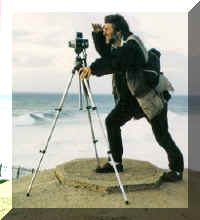
Seewald working San
Sebastian, Spain '94
(And here he uses a Hasselblad, a 2 1/4 inch square negative- makes for GREAT enlargements, up to 40x50").
Photo copyright Valerie Seewald '94
Seewald walks onto a street in Milan, Italy, turns left, and through a darkened portal views a dynamic scene. People are rushing about; streetcars and busses are making their way through the portal. Soft light and the portal's framing effect produce a sense of flattened perspective. Muted splashes of green and red highlight the otherwise monochromatic composition.
In the mid-'70s he knew of no one who produced that type of photography for a living. Then he saw an exhibition of Ansel Adams' work.
Over three hours Seewald takes picture after picture of the scene, [taking one shot every 5 to 15 minutes] employing a two-second exposure so that pedestrian and vehicle movement blurs. But as with the Genoa seascape, Seewald senses something missing in the photograph. Finally, after the thirtieth exposure, the composition locks into place. Two men in silhouette start conversing at the image's lower left. Seewald makes the picture, with an iron-red streetcar, its motion ghosted, plowing into the center of the frame.
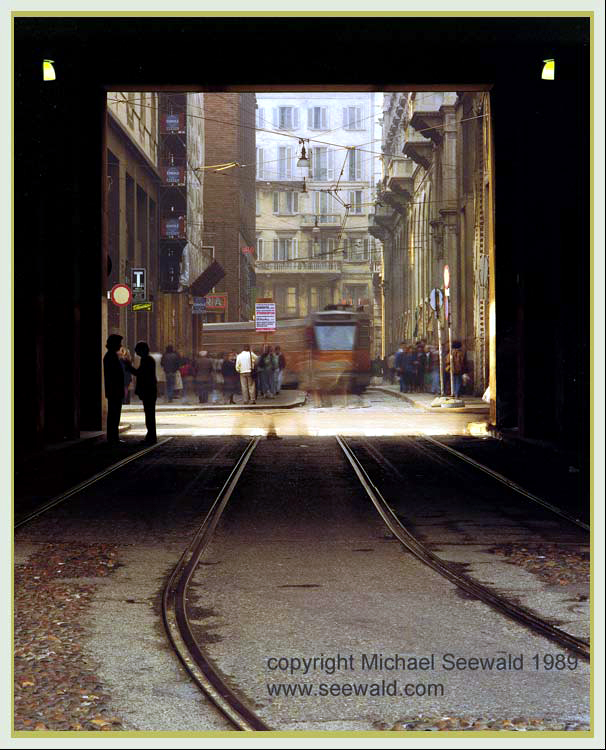
Sponsored by Grace Fang of San Francisco, Ca.
Milan, Italy '89
Seewald's photographs frequently convey a painterly feeling. That's no surprise. At around five years old he already dabbled with paint-by-number kits. Then, he started creating original paintings (even today, Seewald periodically picks up a brush).
At 12, Seewald received his first camera, a box Brownie. Almost immediately be became the family photographer, taking snapshots of vacations and holidays. He remembers the early thrill of photographing.
"There was an excitement about the imagery the camera could produce. It could capture the moment.'
After high school, Seewald enrolled at Southwestern College near San Diego. Utilizing the school's photo labs, he taught himself darkroom procedure, including color printing. He enjoyed experimenting in the darkroom, and found the work came naturally.
Upon receiving an associate degree from Southwestern College in the mid-1970s, Seewald moved to San Diego State University, enrolling in the university's photojournalism program. For two years he served as a staff photographer for the Daily Aztec, S.D.S.U.'s newspaper. He enjoyed the news work; still, deep down, Seewald knew photojournalism wasn't what he wanted to do over the long haul. For one thing, something he heard on his first day at S.D.S.U. startled him. A journalism professor told Seewald and his fellow students that journalists, because of deadline pressure and other stress, suffer a high heart attack rate. "It wasn't too enticing to hear that," Seewald recalls.
This friend said he had tripled his business since finishing the course. Seewald thought it wouldn't hurt to take the class.
In addition, he began finding photojournalistic work confining. "With photojournalism you're given assignments," he says, "meaning you might be told to go somewhere you don't want to go, or asked to photograph events you don't want to shoot."
On the other hand, Seewald saw that fine arts photography allowed him unfettered creativity. He could approach a subject any way he wanted, and not worry about the photograph pleasing someone in a certain manner. The photographs he made for his photojournalism classes began carrying a fine arts "signature."
But while in school, Seewald didn't give thought to pursuing fine arts photography as a career. In the mid-'70s he knew of no one who produced that type of photography for a living. Then he saw an exhibition of Ansel Adams' work.
"I saw this show around my second year of college, and my respect for fine arts photography just soared. I thought, This must be a great job, traveling and photographing these beautiful places. I was impressed. The quality of Adams' prints was above and beyond anything I'd seen. His work made me realize that photography was something that could be displayed in a gallery. I'd never before seen photography in a gallery."
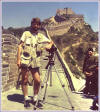
Seewald working with his Mamiya RB67 'studio camera'
during his second sponsored series, China, 1987. (Studio being as it's too heavy for most photogs to 'lug' around the world)
Click photo to enlarge
Bartending. Selling newspaper and magazine advertising. Selling furniture. These are the jobs Seewald held after graduating San Diego State University in 1976. At first glance, not the prestige positions one expected an ambitious college graduate such as Seewald to pursue. Nonetheless, he managed to tie his photography skills into the jobs.
For example, selling ads. He'd produce the required commercial photographs. As a bartender he hung his color seascapes and landscapes behind the bar, and to his surprise they sold. This success led him to think about opening his own fine arts photography gallery. In 1983 Seewald's Photographic Gallery, located in the funky San Diego coastal community of Leucadia, became reality.
Seewald sold his first sponsorship, $125.00 for a 16 x 20 print, to a Seewald Gallery customer who originally had come in to purchase a Brett Weston image.
Seewald intended the gallery as an outlet for himself and other art photographers. Originally he planned to support the gallery and an accompanying studio through his bartending job. But a disagreement between himself and the bar owner forced Seewald to leave that job, and suddenly the gallery found itself without financial backing. Seewald borrowed $500 from his grandfather to pay the gallery space first months rent. Still, money was so tight Seewald couldn't even afford to paint the gallery walls.
For several years Seewald struggled to keep the gallery open, working almost every day. It was impossible finding time to create new photographs, so he tried selling work he had produced prior to the gallery's launching. Slowly, however, Seewald felt himself sinking into a mire. He wasn't selling enough work to keep up with his rent and bills.
In 1986, despite the bleakness of his situation, Seewald decided it was time to produce new photography. A friend asked him to accompany her on a journey through China, and Seewald saw the photographic possibilities. But then he came up against the trip's $1,500 cost, and once again he felt stymied.
'I knew then that God was involved. I asked Him to help me come up with a way for funding the China trip.
At around the same time, another friend told Seewald about a man who taught a self-motivation and positive thinking seminar. This friend said he had tripled his business since finishing the course. Seewald thought it wouldn't hurt to take the class.
'I had nothing to lose - I seemed to be going downhill rapidly at that point. So I signed up for the [Robert J. Sturner's 'SUPERLIFE'] class. It cost $600, and since I didn't have the money I arranged to make time payments.
"While I was taking the course, what struck me most was the concept brought out that successful people maintain some kind of contact with God. Maybe, I thought, that was what was missing in my life ... maybe it was time to start asking God to become part of my life."
"I wasn't a religious person, but I'd paid for the course, [may as well listen to him and think positive] so I decided to ask God for help. I asked him to show Himself. And it's funny, soon after, as I was in the darkroom printing, right as I would slide the print into the developer, the timer arm would be sweeping the zero. After four or five times I thought it was a coincidence. Yet after 30 times the same thing kept happening. Every time I put a print in the developer, the timer arm would sweep zero. [The odds where two in 120 it would happen twice in a row, three in 180 three times, etc.. The odds for 30 times- IMPOSSIBLE in trillions of years].
'I knew then that God was involved. I asked Him to help me come up with a way for funding the China trip. Slowly, the idea came to me to set up the sponsorship program... to ask people to pre-purchase the work I'd be creating on the trip."
This begs the question: Isn't it dangerous to travel this way carrying expensive camera gear?
Seewald sold his first sponsorship, $125.00 for a 16 x 20 print, to a Seewald Gallery customer who originally had come in to purchase a Brett Weston image. This sponsor would have first pick of any of the images Seewald produced on his trip. Soon after, Seewald sold several more sponsorships. He now saw his dream taking new root.
[Note: To date, Seewald has made 61 photographic expeditions, to countries and regions as distinct as Russia, all of the Hawaiian Islands -twice or more each, Cuba, Spain, India, Turkey, Italy, Bali, Vietnam, Ireland, Germany, Australia, Costa Rica, Greece, Peru, Japan, Iceland, Morocco, New Zealand, Israel and Kenya, to name a few ...averaging 3 to 4 weeks each.]
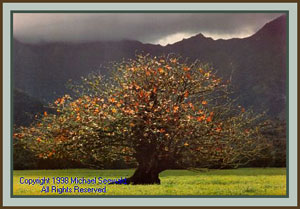
Kauai 'False Kamani' Tree, '88
Sponsored by six time sponsor Jay and Heidi Short of Rancho Santa Fe, California.
Click image to enlarge.
As he's undertaken each expedition, Seewald has seen the price his work commands rise significantly. Before leaving on his first trip, Iceland, July 1986 (Seewald ended up postponing his China trip until 1987, converting the original China sponsorships to Iceland) he sold 25 sponsorships, most at $175 each.
On his autumn 1992 journey to Russia and several former Soviet bloc countries, Seewald sold a dozen sponsorships, charging $600 for a 16 x 20 image and $900 for a 24 x 30. In a few years, he expects these photographs to be worth several thousand dollars. For example, one of his Iceland photographs, sponsored for under $200, later sold for $1,500.
Use of color also distinguishes a Seewald photograph - "understated" is the key word here.
Traveling for Seewald is a low budget affair [was, thank you Lord!]. Spending about one month in a country, living out of a backpack and photo vest, he sleeps in parks, abandoned buildings or under overpasses. A night in a youth hostel is a luxury, and in Russia, notes Seewald, he slept on overnight trains. There, the equivalent of $1.75 buys first class sleeper accommodations.
[Note: The Iceland images are now valued at $40k ea., minimum, and China $20k and up (with two now having a $100,000 asking price, due to rarity and availability). Also, it now runs $1,500 to sponsor a 16"x20", and $2,700 for a 24"x30" photograph].
"On average, I spend $5 to $6 per day on a trip, and that includes food," Seewald says. "I'll get into a town or city, and the first thing I'll do is go into a bar, order coffee, and make friends with the owner. I'll ask if I can stow my backpack behind the bar, then go out photographing. While I'm working, I keep my eyes open for a place to sleep that night."
This begs the question: Isn't it dangerous to travel this way carrying expensive camera gear?
"I live with my camera equipment," answers Seewald. "I never leave it. It's part of my body; I sleep on it. Actually, I don't sleep well on a trip - I always have an eye open."
Fortunately, Seewald never has been robbed of anything significant while on the road. Still, he's had some close calls.
"I've been invited to sleep in places where, after arriving, I've had second thoughts ... did the people who invited me actually want to steal from me? [the guy was drunk when he asked me] It can get nerve-wracking."
Seewald's images communicate in a quiet, lyrical way. Speaking to the photographer, one feels that this is an individual so in love with his art, ...
In order to produce the sharp, fine grain, large-scale photographs his sponsors and other clients want, Seewald works in medium (120 mm- 6x6cm) format. He's accomplished most of his work with a Mamiya RB67 and 50mm, 90mm and 180mm lenses. But recently, after the Mamiya system "finally wore out," Seewald switched to Hasselblad. 'It's a pleasure working with the Hasselblad," he notes. "It's so light.'
Seewald works strictly by available light, favoring early morning, late afternoon or overcast situations. He primarily shoots Kodak professional film [still shooting with it, T.U.L, but purchased a 'digital back' for it in 2013, so now it's all digital]., and uses a polarizer on exposures - 'It always seems to take the gloss off something." He prints his own images up to 16 x 20, utilizing a paper known for its archival quality, Fuji Type C FA3. [now Fuji Crystal Archive, rated 200 year light-fastness]. An outside lab produces larger prints.
Working from a tripod, Seewald can spend hours setting up a photograph, and typically produces two images each day. He never sets a shutter speed faster than one second, thus creating what he calls a 'Seewaldian' trademark: image motion.
Use of color also distinguishes a Seewald photograph - "understated" is the key word here.
When I started approaching the fine arts color work in the early '80s, I didn't create anything I liked for two years," explains Seewald. "I was under the impression that color had to be 'super-sunset color,' the postcard effect. Then on an overcast day, I created a composition involving some rocks that were almost pure gray, with just a touch of color. That's what I was looking for, color on the subtle side."
Seewald's images communicate in a quiet, lyrical way. Speaking to the photographer, one feels that this is an individual so in love with his art, so in love with the world, that he'll work for as long as he's able to see, as long as his legs and arms will carry him. Adversity does not stop Seewald. If anything, it fuels him, and we're fortunate to be able to enjoy the results.
Reprinted with permission, Photographers Forum magazine, Nov. '93 issue. Some numerical facts updated through 12/'09.
_____________________________________
Find out about current pricing and sponsorship opportunities.
_____________________________________
To: North County Times article. "Local photographer captures own reality".
_____________________________________
More on Seewald's spiritual influences.
_____________________________________
|
Just Posted:
Michael no longer needs his super high quality, but 'smaller' digital camera, so he is selling it . The picture quality is exceptional.
NOTE: it DOES have a few small dings,
but still works great, and thus the great low price...
View the great deal, as well as this fantastic picture
he took with it, just before
being rushed to the emergency room at the hospital!
Click here to view.
|
Media Coverage
Television Interviews
Award Winners
Old Gallery Locations
Trip Highlights
Seewald's 2011 China museum exhibition
Seewald's Paintings Hobbies: Fishing Dept.
Spiritual Influences Seewald's Accident Miracle
For HHasselblad photos, Hasselblad photographs , dan mcgeorge, stock photos and photogrs worth collecting, collections and their collectors, artwork, photos by masters, master photographers, and stock ophotos art gallery, photographic art, masterpieces, photos, photographs by masters, stock photos by Michael seewald, Michael Seawald, mihcale sewadl, Ansel Adams, Italy, Tuscany, Provence,
master photographers, seawald, joseph bellows gallery, quint gallery, brooks institute, peter fetterman gallery, alinder gallery, joseps daniels gallery, sewald, seewall, seawall, seawald, cewald, black and white,
museums, color photography,photo workshop photos, Del Mar Plaza,
|
